Schema markup for SEO was introduced in 2011 as a way to help search engines better understand the contents of a page.
You may be familiar with some types of schema already: ratings, reviews, events, and recipe schema can all be found on the search results pages for certain queries.
In 2018, Google introduced the FAQ schema to provide the most useful, relevant results for end users. Testing occurred until May 2019 and the schema has been open for everyone to implement ever since.
Below, we're going over everything you need to know about FAQ schema to help you get started using it.
Table of Contents:
What is FAQ Schema?
Many web pages house a frequently asked questions page that users can turn to for quick clarifications on the site's products, services, policies, etc.
The FAQ schema takes those questions and their respective answers and turns them into structured data so that both the question and answer appear on the Google SERP as a rich snippet.
This means that users can get answers to their specific questions from a certain website without having to leave the SERP.
Here's an example:
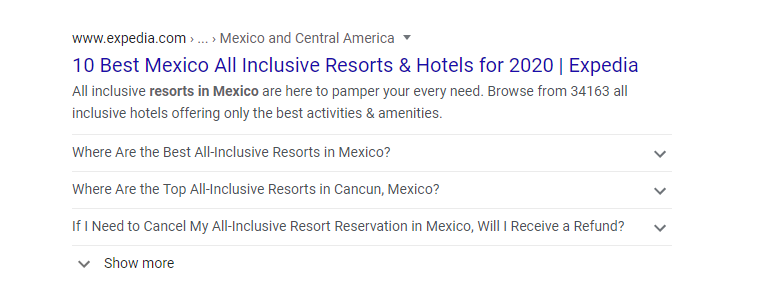
(An example of the FAQ schema in the search results for a travel-related query.)
Why is FAQ Schema Important for SEO?
In addition to improving the user search experience, you probably noticed that the FAQ schema caused the listing to be larger than normal. This increased SERP real estate increases your site's search visibility and draws the user’s eye.
Because of this, listings with an FAQ schema typically have a higher click-through rate (CTR) than those without.
The FAQ schema is also eligible for voice search actions — Google says this structured data can have an action on the Google Assistant.
As for specific industry information, we especially see the aggressive nature of FAQ schema in the travel and coupon industries.
At seoClarity, we’ve also tracked an increase in FAQ schema for two clients in the delivery and pharmacy industries, with an increase from 16% to 21% and 10% to 22%, respectively. Percentages represent the number of tracked keywords with an FAQ schema.
FAQ Schema Best Practices
Like most other components of SEO, Google has guidelines in place for the FAQ schema markup so the search engine can properly pick up on it.
These guidelines explain where to add the schema markup and, perhaps more importantly, where not to.
#1. One Answer Per Question
The FAQ schema can be added to pretty much any page that has FAQ-type questions and answers.
This would include blog posts, service pages, product support pages, and, of course, FAQ pages that address common company questions.
But, according to Google's documentation, the FAQ schema should only be used where there is a single answer to each question.
As such, it should not be used for web forums where there is one question, but any site visitor can input an answer. In cases where there is more than one answer to each question, the QAPage schema is a better option.
#2. Don't Use FAQ Schema for "How To" Content
While it may seem applicable (e.g. How do I fix a clogged drain?) the FAQ schema isn't meant for how-to content. This is against Google's guidelines.
If you're looking to add schema to your how-to content, don't worry. There's a designated schema type for this purpose known fittingly as "HowTo" schema.
#3. Don't Use the Markup for Advertising Purposes
Schema is meant to give search engines more context about your pages' content and hopefully offer users a direct line to valuable information if it results in a rich result.
For this reason, it's against Google's guidelines to use the FAQ schema for advertising or promotional purposes.
#4. Avoid Repetitive FAQ Content
Google also recommends that if you have repetitive FAQ content on your site (i.e. the same question and answer appears on multiple pages) you should only implement that specific FAQ schema once for the entire site.
A web crawler can help spot these duplicate questions. You can also run a schema audit.
#5. No Hateful or Profane Language
Google makes it clear that the following types of content won't be displayed as a rich result:
- Obscene
- Profane
- Sexually explicit
- Graphically violent
- Promotion of dangerous or illegal activities
- Hateful or harassing language
As such, you shouldn't implement FAQ schema on any pages that include content with such characteristics.
#6. Answer the Question Entirely
Both the question and answer need to be written out in completion in your schema code. After all, the entire question and answer may be shown as a rich result, so there can't be any fragments.
Tip: The question and respective answer need to be visible to the user on the page. You can't just list the FAQs in the schema snippet and not on the page source.
Which Questions to Answer in Your FAQ
Your customer success department is often the best source of commonly asked questions about your products/service and their answers. After all, it's their job to be in close communication with clients or prospects.
These insights can be converted into FAQ content for specific product pages.
Google’s People Also Ask can also serve as a source of inspiration for frequently asked questions.
seoClarity clients can view top People Also Ask Questions collected by topic to use for this purpose…
Recommended Reading: Testing FAQ Schema for Greater Search Visibility and CTR
How to Come Up With FAQs at Scale
It can be tedious and time-consuming to manually search Google for People Also Ask suggestions to generate questions. And if your organization operates in silos, then collaborating with the customer success department may not be the most efficient approach.
To help our clients better understand how people search for their target keywords at scale, we integrated People Also Ask into Content Fusion, our AI-Driven content optimizer.
Content Fusion pulls in the People Also Ask questions from the Google SERP in real-time so you can stay informed on what questions end users are asking. Then, all you need to do is answer them to generate FAQ content that can be turned into the FAQ schema.
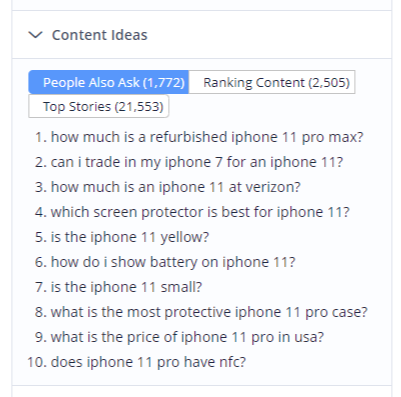 (People Also Ask for the keyword “iPhone 11” in Content Fusion.)
(People Also Ask for the keyword “iPhone 11” in Content Fusion.)
How to Implement FAQ Schema
To add the FAQ schema to the SERP, you need to create the right code format with the questions and answers labeled accordingly. Then, implement that code on your pages.
Now, not all SEOs know how to write schema code. Even devs can be unfamiliar with the language.
Luckily, generating schema markup is now point-and-click easy with Schema Builder - a free Chrome extension. A few clicks will generate your schema code for you in JSON-LD format. Then, all that's left to do is implement!
Recommended Reading: Schema Markup Generator: Build Structured Data Without Developers
Once you’ve copied the code and adjusted the questions/answers appropriately, load the code into the page’s settings on your Content Management System. Most CMS’s have an advanced setting for code snippets.
In HubSpot, for example, it looks like this:
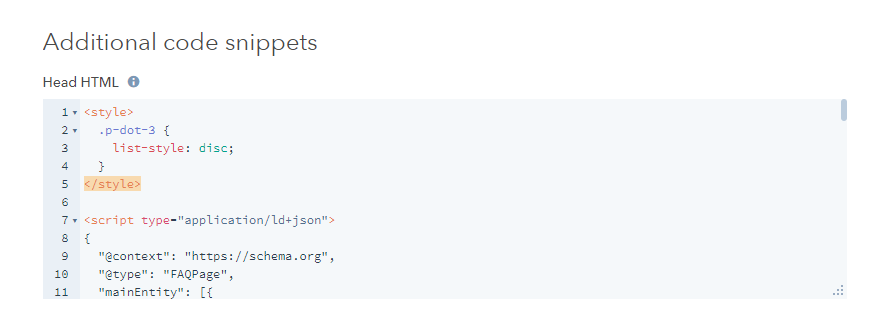 (Additional code snippet section of the HubSpot CMS.)\
(Additional code snippet section of the HubSpot CMS.)\
But we realize that not all SEOs have direct editing access within the CMS. Usually, any site changes have to go through dev — and that can take anywhere from a few days to a few weeks.
Not anymore.
Schema Optimizer lets you scale your schema implementation across your entire site with just a few clicks. Implement schema across thousands of pages according to the variables you set up.
How to Test Your Schema Code
Implementing code on your site can be a nerve-wracking process and you may question if you’ve done it correctly.
Since even a small typo can ruin everything, it's always important to double-check the code — even if you’ve done this process before.
There are three methods we recommend you follow to check your code:
-
Google’s Rich Results Test
-
Schema Tester
-
Use an SEO Platform
Let's go over these in more detail below.
#1. Google’s Rich Results Test
One step in the verification process is to run Google’s rich results test.
Here, we’re going to input a published piece of content’s URL to test if that page is eligible for a rich result. To do so, input the content’s URL in the text bar and click “Test URL.”
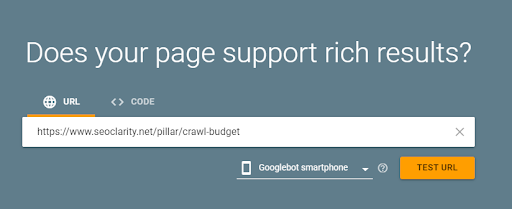 (Enter the URL or code to see if the page is eligible for a rich result.)
(Enter the URL or code to see if the page is eligible for a rich result.)
You’ll be alerted to whether or not your page is eligible for rich results. If the test is successful, you’ll see a message that reads “All structured data on the page can generate rich results,” as well as the detected items (i.e. FAQ).
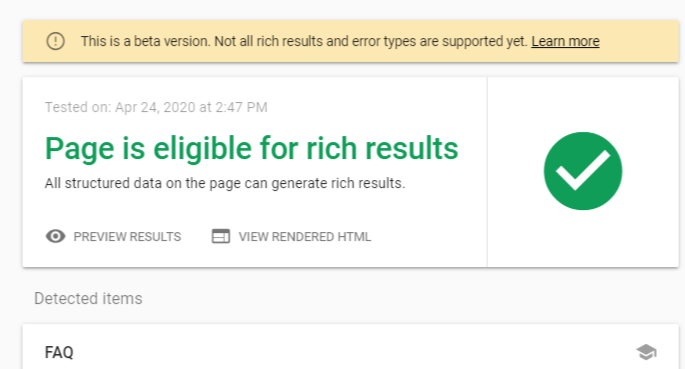 (Our URL is validated as being eligible for rich results.)
(Our URL is validated as being eligible for rich results.)
#2. Schema Tester
Another option is to use our handy Chrome extension, Schema Builder. In addition to building schema code, it can also test it!
This way, your schema building and testing can live in one cohesive environment.
#3. Use an SEO Platform
To test schema at scale and make sure it's being picked up properly, leverage an SEO platform to run a schema audit.
A structured data audit will tell you how many pages had schema out of the total number of pages crawled, the different schema formats (JSON-LD, Microdata, and RDFa), and more.
It's the best way to validate your schema implementation across thousands of pages.
Conclusion
The FAQ schema is an easy-to-implement secret weapon for increasing your search visibility and CTR, whether it be for a dedicated FAQ page or blog content.
The increase in the size of your listing draws the user’s eye and the useful information offers a positive user experience. Plus, you give Google an extra clue as to what your page is about.
The SERP is always changing and so is the way we measure search visibility.
For a new way to track search visibility on the SERP, reference seoClarity’s updated approach to rank tracking: Visibility Share.









1 Comment
Click here to read/write comments